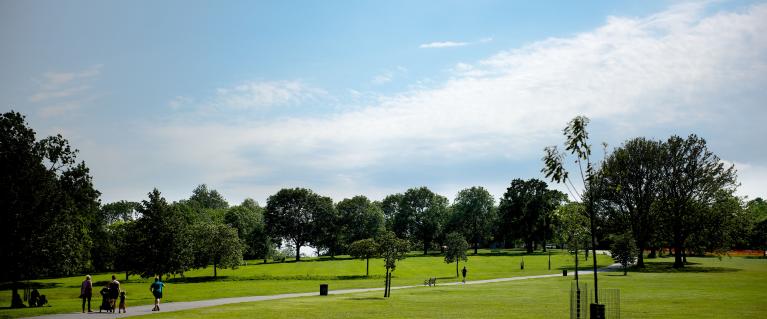
Parks and green spaces
London is a surprisingly green city, with around 3,000 parks and a vibrant network of canals, reservoirs, and riversides to explore.
In fact, around 20 per cent of London is public green space. And almost 50 per cent of London is green and blue from above, including trees, green roofs, road verges and private green space. That’s more than all its railways and roads combined.
Alongside London’s trees, these green and blue spaces make the capital a better place to live for all.
What we’re doing for our parks and green spaces
In July 2019, London was declared the world’s first National Park City with over 50 per cent of the city green by 2050. We want to make our parks, green spaces and waterways places people can enjoy and wildlife can thrive.
Improving parks and green spaces
In a bustling city like London, parks, woodlands, rivers, and wetlands, provide spaces to relax and connect with each other. They’re also places that encourage us to be active, whether cycling or walking, or exploring nature with family and friends. Trees and green spaces also provide shelter from the sun and help us to stay cool as the climate heats up.
The Mayor has invested almost £30m in London’s green spaces. From restoring rivers, to new wildlife habitats, and space to play, green spaces are vital to our health and wellbeing.
An example is our Grow Back Greener Fund. Running from 2020 - 2023, it planted trees in London's communities to provide shade, and create and enhance green space.
The fund awarded over £4 million to 135 cross-capital, community-led projects. And supported Londoners to make the city greener, wilder and more resilient to climate change impact.
Valuing our parks
London’s first Green Spaces Commission report was published in August 2020. It included two key recommendations on how to bring the best out of London’s parks and green spaces:
- Develop a Centre for Excellence to champion and secure funding for these spaces.
- Develop a green skills programme.
Parks for London was established at the Centre for Excellence to develop a more collaborative approach to managing and funding these spaces in future.
As well as this, the Mayor protects parks and green spaces through the new London Plan. This includes encouraging more urban greening on major developments through the Urban Greening Factor and encouraging proposals that enhance open spaces to provide a wider range of benefits for Londoners.
Accessing parks
The Mayor wants every Londoner to be no more than a 10-minute walk away from green space. We’re focusing our work and funding to help make this happen. Examples of this include our Grow Back Greener and Green and Resilient Spaces funds.
Today, more than ever, we need a network of green infrastructure. This will help protect London for future generations. It will also provide a happier, and healthier city to live in.
Our Natural Capital Accounts for Green Spaces in London report outlines the economic value of these green spaces. It shows that every £1 spent by local authorities and their partners on public green space, brings at least £27 in value to Londoners.
How you can get involved
Londoners can help care for our green spaces too. If you’d like to help make our city greener, healthier, and wilder, here are some ideas on what you can do.
If you’d like to help spruce up your local park, you join a ‘Friends of Parks’ group. The charity Parks for London has lots of ways you can get involved. You could also sign up for the Mayor’s volunteering scheme, Team London.
The Royal Parks
London has eight Royal Parks including Hyde Park, Green Park, and Richmond Park. These iconic green spaces and landscapes are enjoyed by millions every year. They are also home to a wide range of wildlife.
The Royal Parks charity manages these parks and other open spaces for the government. It board is set by the Mayor, and the Secretary of State for Digital, Culture, Media, and Sport.
Thames Barrier Park
This seven hectare green space in Newham opened in November 2000. Set in the Royal Docks, it was London’s largest new riverside park for over 50 years. As well as abundant wildlife, there are picnic and children’s play areas, a basketball court, visitor pavilion, and a coffee shop.
Need a document on this page in an accessible format?
If you use assistive technology (such as a screen reader) and need a version of a PDF or other document on this page in a more accessible format, please get in touch via our online form and tell us which format you need.
It will also help us if you tell us which assistive technology you use. We’ll consider your request and get back to you in 5 working days.